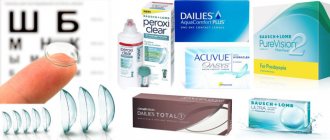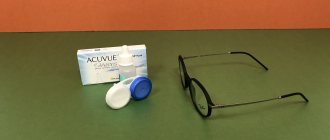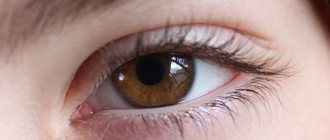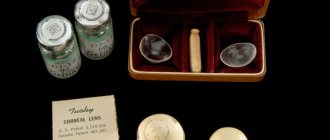Some people are born with various defects of the cornea, pupil or iris. In addition, they can be acquired during life due to various injuries or diseases. To correct external imperfections, it is not necessary to undergo surgery. Aesthetic eye prosthetics using colored lenses allows you to skillfully hide such defects. Many companies produce regular decorative lenses to enhance or change eye color. They can be with optical power to correct refractive errors or with “zero” diopters for users with good vision. It is not difficult to buy such models in optical stores or order them in specialized online stores.
To hide visual defects of the eyes - for example, a “torn” pupil, the absence of part of the cornea, etc. — special lenses are needed for aesthetic prosthetics. They have a dense painted layer and are manufactured individually using special technologies. Who needs to wear such optics?
Trends for Women's Sunglasses
Matvey Kesheshyan
fashion stylist
– Sunglasses for the spring-summer 2021 season have become more moderate in decor. Instead of bright rhinestones, geometric shapes and futuristic designs appeared,” says Matvey. – Glasses borrowed from divers and skiers are trending.
But the most current shapes still remain round and “cat’s eye”. Colored plastic is also still in fashion.
Color contact lenses
With soft colored contact lenses, you can radically change the color of your eyes, even for those with a rich natural brown color. The second name for such lenses is cosmetic. Today it is easy to purchase similar lenses in a variety of colors, from soft emerald, blue and violet to honey-tea or sapphire. Colored cosmetic lenses have one characteristic difference: they are produced with a complex pattern applied that imitates the iris. The drawing area is opaque, that is, it has no optical functions. Only the transparent, uncolored central zone of the lenses, located directly opposite the pupil of the eye, is intended for vision.
Caring for aesthetic contact lenses
This type of optics is made only from hydrogel materials. The wearing mode of such contact lenses is daily, and the replacement period is on average one year. It is under no circumstances recommended to leave lenses on your eyes overnight, much less wear them for several days. Such optics require regular maintenance using universal and enzyme solutions, and also require deep cleaning once a month using peroxide systems. The ophthalmologist will give recommendations on what products will need to be purchased for disinfection.
The lifespan of aesthetic lenses may be shortened depending on appearance. Thus, the design on models made using computer technology is much more durable than that of lenses painted by hand. Some overly aggressive solutions with preservatives can speed up the fading of the painted area.
If contact lenses for prosthetics are used from time to time (for example, in the summer you can use sunglasses so as not to wear optics), then between wearing them they should be stored in a universal solution, changing it every 10 days. You can buy various care liquids at opticians or on specialized websites selling ophthalmological products.
Aesthetic prosthetics using special contact lenses brings good results for people with various external defects of the cornea, iris or pupils. After all, they bring not so much physical as psychological discomfort. A person is embarrassed to go out and communicate with strangers. With the help of modern technologies, it is possible to produce lenses of various types that hide imperfections and allow you to lead a normal lifestyle.
Selection of contact lens parameters
When selecting contact lenses for prosthetics, the patient’s vision should also be taken into account, since this type of lens, among other things, can provide the patient with the correction of refractive errors.
Therefore, in the prescription for such lenses, in addition to their basic curvature, the color of the iris, its diameter, as well as the diameter of the pupil (in low and bright light) and the lens itself, the optical power must be indicated. The diameter of the pupil on the lens will depend on the patient’s type of activity and lifestyle. Soft contact lenses will contribute to a high level of wearer comfort. If the patient's eye defect covers a large enough area, lenses of increased diameter may be required that can cover the entire front surface of the eye, thereby hiding any visible defects. Since most prosthetic contact lenses are not trial lenses, the user will still have to pay for each lens that does not fit. Silicone hydrogel lenses cannot be tinted, and therefore patients with eye defects are most often limited to traditional hydrogel contact lenses. If possible, the specialist should first order clean (without a pattern) contact lenses with the necessary parameters, which will allow more accurate checking of indicators such as fit on the cornea, quality of vision correction and comfort. In addition, re-ordering clear contact lenses for optimal fitting will be less expensive than re-ordering ready-made, patient-tinted prosthetic contact lenses. When you finally manage to pick up clean contact lenses, then you can send them to the laboratory to apply the necessary design. As we have seen, the use of aesthetic prosthetics using special contact lenses can bring good results, if, of course, the specialist learns to take into account many factors that were discussed in this article. Dawn Lam, Doctor of Optometry and Assistant Professor Dawn Lam teaches corneal treatment and contact lens fitting at the Southern California College of Optometry at Marshall Ketchum University . Spectrum from 03/01/2015 URL: https://www.clspectrum.com/articleviewer.aspx?articleID=112352 (date of access: 03/29/2015).
Other related articles:
Contact lenses and contact vision correction
Which contact lenses are better?
Girls: these are the frames that are in fashion now
Round face: you need to visually lengthen it, so choose dark-colored frames . They narrow the face and bring it closer to an oval. To balance the proportions, choose frames that are wider than they are tall. So, pointed, rectangular and square glasses, as well as wayfarers, .
Oval face: the main thing here is not to disturb the harmonious proportions. Therefore, avoid glasses that are too massive. Make sure that the top of the frame coincides with the eyebrow line. are suitable : rectangular, oval, round.
A square face shape needs to be visually balanced and softened. Rounded frames will help with this. Rectangular or square sharp shapes will overload the face. With this shape, you should choose large oval and round glasses, glasses with colored or teardrop-shaped frames.
Cat frames and aviators are suitable for absolutely any face shape.
Can contact lenses be defective?
Of course, if you buy contact lenses in a specialized online store or optical shop, you avoid the risk of stumbling upon products of poor quality. However, there is still a chance of purchasing a low-quality product; you may come across packaging with a manufacturing defect.
Contact lenses are sold in sealed packaging, so it is impossible to detect defects upon purchase. The term “defective products” refers to lenses on the surface of which, immediately after opening the blister, various chips, cracks, deformations and other damage are detected. Fortunately, these contact lenses can be returned to the store or optician where you purchased them. After the return, you will receive monetary compensation in the amount of the cost of the product or the product will be replaced. An important point - the lenses must be unused; after the first use, the product cannot be returned!
Some buyers consider contact lenses to be of poor quality if they do not meet their expectations:
- They do not sit comfortably on the eyes, but at the same time they correspond to the parameters in the doctor’s prescription. It should be taken into account that contact lenses from different manufacturers with the same parameters may be positioned differently on the cornea. In this case, it is recommended to select lenses by trial.
- Damage to the lenses was caused by your fault, for example, during putting them on.
- Colored contact lenses do not look the same in your eyes as in the photo; you don’t like the color or pattern.
None of these are reasons to consider the lenses defective and subject to return. If the lenses were initially damaged or poorly made, then you can indeed exchange them or return the product for a refund. You will need to present: the product, packaging and a document confirming the fact of purchase. It is important that no lenses are used.
You can return defective optical products only if the seller confirms the presence of a defect. The defect is usually clearly visible, so problems usually do not arise. However, in some cases an examination may be required.
Why should you never wear defective contact lenses?
Wearing defective contact lenses can harm eye health, cause blurred vision, and the occurrence of infectious and inflammatory diseases. Even minor scratches or deformations can significantly damage the eyes. Do not experiment with wearing damaged contact lenses!
The feasibility of correction - is it necessary to hide strabismus at all?
There are different types and degrees of heterotropy. It is worth hiding the pathology only if the eyes are separated from each other by a decent distance.
A mild form of pathology is not noticeable to others
If the defect is minor, then there is no need to hide it. For many people, a slight deviation of the pupil from the normal axis gives it a special charm and charm.
Fact: Some stars deliberately do not eliminate slight heterotopia, as they consider it their “highlight”.
Jennifer Aniston has made a career out of having divergent heterotropia
Cosmetic correction may be needed if:
- there is obvious divergent strabismus;
- there is a severe degree of paralytic strabismus;
- the eye moved strongly to the bridge of the nose.
Convergent strabismus is more aesthetically acceptable than all other types of this disease.
If one of your pupils has moved a little towards your nose, and your vision has not deteriorated, look at it from the other side. Ask friends, acquaintances and loved ones. Perhaps this feature will even make you more attractive and charming in the eyes of other people.
Narrow pupillary zone of colored lenses
On our website you can buy colored lenses with a narrow pupillary zone.
First, let's look at what the pupillary zone of a lens is.
All models of colored lenses, with the exception of some types of crazy lenses, have an uncolored area in the center - the pupillary zone, which is necessary so that the pigmented part of the lens, when worn, does not completely block the view or color the surrounding world in the color of the lens. Since manufacturers have recently been trying to create more natural lens designs, the pupillary area is made narrower so that the natural eye color is not noticeable, or is only visible minimally through the transparent part in the middle of the lens. Of course, I would like the natural shade of the iris in the area of the pupillary zone to not be noticeable at all, but since the pupil tends to change its size during the day - to narrow and expand, it is only possible to create a model in which the size of the pupillary area would cover most of the iris around the pupil.
Many colored lenses on our website include colored lenses with a similar design, but let's look at the pros and cons of this type of pupillary zone using the example of Cloud models from the Korean manufacturer Urban Layer.
Firstly, it is important to note that lenses from the Cloud line are suitable for any natural eye shade, including the darkest. Excellent coverage of the natural color of the iris is achieved due to the fact that the lens is densely pigmented, since the manufacturer took into account the fact that previously, owners of dark eyes had problems choosing light shades of colored lenses, since most models created only a slight tinting effect.
Now let's return to the question of the pupillary zone, as written above in Cloud it is narrow, due to which the same, more natural color overlap is achieved, and with a certain pupil size, the lens covers the color completely. But, there is the only disadvantage of this design of the model, it happens rarely, but due to the individual structure of the eye, in some cases, the pigmented part of the lens may extend onto the pupil, blocking the view along the periphery, and therefore it may feel like you can see in the lenses cloudy. Unfortunately, it is impossible to say in advance whether such a situation will occur in each specific case, since the choice of colored lenses is a very individual process. Since the occurrence of this type of discomfort is caused by individual characteristics, and not by the presence of a factory defect in the lens, returns and exchanges are not made.
If you have sensitive eyes or are concerned that the pupillary area is too small in diameter, we recommend choosing models with a medium or wide pupillary area. To get advice on this issue, you can always contact us, we will be happy to answer all your questions.
Enjoy the shopping!
Marshal
“Marshals” seem to combine the feminine and masculine principles. Therefore, a rather rough shape emphasizes the femininity of a woman’s face and enhances the masculinity of a man’s face.
We took all the photos in the Ray-Ban brand store on Nemiga.
Disadvantages of colored lenses
It is no secret that the level of illumination causes our pupil to change shape - to narrow and expand. When wearing colored lenses, it may happen that the dilated pupil becomes larger than the uncolored area of the lens intended for vision, which causes a feeling of interference.
Also, with a loose fit, the lenses often move significantly during blinking. In this case, the pupil turns out to be closed for some time by the colored part, and vision literally disappears for a few seconds.
Tinted contact lenses do not have such disadvantages due to absolute transparency and uniform coloring.
Makeup for glasses
17. Frames tend to cast a shadow under the eyes, so you should use a yellow concealer to neutralize the shadow
.
18. Remember: the frame frames your eyes, and the eyebrows frame the frame.
. Therefore, it is worth paying special attention to the shape of the eyebrows.
conclusions
Colored lenses are very popular today because... people love the before and after results. The ability to change the color of your eyes depending on your mood attracts many. So, you can change the color of your eyes in accordance with your clothes, weather, and your created image, every time you go outside. These lenses do not require special attention to care for, and they are quite affordable. But most importantly, daily colored contact lenses are absolutely safe when worn correctly. So go for it: change your look, even to the point of radically changing your eye color!
How much do contact lenses cost? Read the following link.
Colored plastic
Glasses made of colorful plastic seem to be firmly established in the fashion world. The current season's collections of fashion accessories, and this time again, are not complete without sunglasses made of plastic in a variety of shades.
The color of lenses and frames can be bright and even acidic.
Tinting of polymer lenses
Polymer lenses (plastic) are a special class of lenses that have distinctive advantages - strength and lightness. In the production of polymer lenses, new technologies are used to a greater extent: new materials are invented, coatings are improved.
High quality and beautiful glasses: set the mood with tinted glasses lenses.
The optical workshop “Your Optics” offers the service of tinting polymer lenses. They can be tinted in any color of the visible spectrum with different intensities to suit your taste.
Colored lenses will make life more vibrant, and dark saturated colors will provide you with excellent sun protection and are therefore suitable as lenses for sunglasses. Tinted eyeglass lenses are incredibly versatile and versatile. Women who often wear glasses can choose the lens tint to suit their taste and create an original accessory for their makeup or clothing.
Tinted spectacle lenses protect against excessively bright light. They are presented as sunglasses or additional light filters, depending on the intensity and depth of the shade. Everyone knows that natural solar radiation consists not only of the visible spectrum, but also of ultraviolet radiation.
Our craftsmen make real works of art from each frame. In particular, fashionable sunglasses are made from lenses that are only half or two-thirds tinted. As a result, the glasses highlight the eyes favorably, resulting in the effect of the so-called “mask” or “gradient coloring”. Tinting polymer lenses is affordable and easy, just get acquainted with the color palette and choose your tone.
— filter (full tinting)
The filter is a colored lens with a slight tint of 15% and 75%. Suitable for everyday wear, computer work, increases contrast, reduces the harshness of artificial light and allows you to better recognize small details. You can choose different shades of tint.
- gradient
With gradient coloring, lenses have a smooth transition from a dark tone at the top (where they are pierced by bright sun rays) to a lighter tone at the bottom. Glasses with this coloring are universal: they are relevant both in summer and winter, outdoors and indoors. Gradient lenses came into fashion more than 10 years ago and are not going to leave the catwalks and streets.
- special tints
Yellow tinted lenses are used when driving a car, while playing sports, hunting, etc. Green tinted lenses are used for medical reasons.
Indications for the use of anti-reflective lenses
In appearance, computer glasses do not differ from conventional optical systems with diopters. However, upon closer inspection, you will notice green, blue and purple tints on the surface of the lenses. This is due to the fact that a filtration coating is applied to the glasses of computer glasses, which reflects glare - the cause of decreased vision when working in front of a monitor. Computer glasses also have an antistatic layer that prevents the glass from being magnetized.
If a patient has reduced vision, doctors usually prescribe anti-glare glasses with diopters. It must be remembered that such glasses do not completely protect the eyes from negative influences, so you need to periodically take breaks from working at the computer. To minimize the harm from the monitor, it is enough to give your eyes a rest for fifteen minutes every hour. For these purposes, you can install a special program on your computer that will remind you of the need to take a break.
Computer glasses are recommended for those people who spend more than three hours a day in front of a monitor. Such optical systems are allowed for both adults and children.
Indications for the use of anti-glare glasses:
- regular and long-term use of technology with screens (phones, tablets, computers, etc.);
- tendency to dry out mucous membranes;
- sensation of cutting or burning;
- tearfulness;
- sand effect in the eyes;
- photophobia;
- redness;
- chronic eye fatigue.
Patients note that when wearing anti-glare glasses, their performance increases due to the fact that eye fatigue is reduced. With use, dryness and burning disappear, as well as pain from overexertion. The frequency of headaches and dizziness also decreases.
Contact lenses
We cannot help patients if
- their diseased eye is equal in volume to or larger than the healthy one,
- as well as in the case of preserved vision on it.
We recommend that they use camouflage contact lenses - standard soft lenses, painted at the client's request (usually similar to the fellow eye) with special harmless paints. In addition to the fact that such a cosmetic lens will cover the eye defect, it will remain gas- and light-permeable. The lens can be either without diopters or with diopters.
A masking contact lens can hide defects in the cornea of the eye, such as a cataract, coloboma (irregularly shaped pupil), cataracts, and absence of the iris.
Our center cannot offer camouflage contact lenses.
Author: Sirotkina Irina Anatolyevna
"Wayfarers"
Many celebrities prefer this model of glasses. Wayfarer was created more than half a century ago. These are trapezoidal glasses with thick plastic frames and temples.
The peculiarity of “wayfarers” is a plastic or horn frame and the shape of the lenses in the form of a trapezoid, which expands upward. The color of the lenses can be either classic black or colored.
What are colored scleral lenses?
This is a type of color optics that covers the color of the entire sclera, the protein shell. Initially, therapeutic lenses were created for the entire eye. They were used to treat a number of eye diseases: absence of the iris (aniridia), keratoconus, microphthalmia and other pathologies. They also helped patients with corneal hypersensitivity.
Later, color options appeared. They were used in films when they created images of the dead and other heroes with a terrifying look with completely, for example, black or red eyes. Soon, full-eye lenses became interesting to ordinary people. Contact optics companies took advantage of this. As a result, there are now many models of scleral decorative ophthalmic products. Today you can buy black, red, white, blue models, as well as lenses with various patterns in any optics salon or online store, as well as lenses with various patterns: radiation sign, snake or cat eye, dragon, dollar and others.
However, actors did not always agree to wear such lenses, citing their harm. This gave rise to many legends about the dangers of colored lenses covering the entire eye.
How to hide squint?
how to hide strabismus Source: bolezniglaznet.ru Pupil deviation can be externally corrected using:
- glasses;
- lenses;
- correct makeup.
Many people, faced with strabismus, begin to feel embarrassed about this peculiarity. They feel awkward when communicating with people and have complexes about how they look in photographs.
If there is no urgent need for strabismus surgery, do not be upset. It is possible to correct a cosmetic defect without the intervention of an ophthalmic surgeon.
How should a contact lens owner prepare for tinting in a salon?
The main rule of the procedure is that there should be no lenses on the eyes. Why? Because even through closed eyes a little dye can get in, which will simply ruin the lenses. Use one of the following options:
- If you can do without lenses, then do not wear them or take glasses with you. After the procedure, you may experience slight discomfort and dryness, which quickly disappear, but it is better to give your eyes some rest.
- If you cannot do without contact correction products, take a case with a solution and moisturizing drops with you. During the procedure, remove your lenses and apply eye drops at the end.
If after staining your eyes become itchy, swollen, or your vision becomes blurred, be sure to consult a doctor.
Guys: these are the glasses that are right for you
In the new season, all classic models of sunglasses for men will be popular. But they will also be supplemented by retro models with modern bright interpretations, which are gaining a second popularity. It is worth paying attention to the new Meteor models and classic round frames.
For a harmonious image, you should select the shape of accessories in accordance with the type of face, however, there are also universal models: oval or round, teardrop-shaped, rectangular and trapezoidal. Therefore, even if you choose the most trendy and stylish models of the season, they may not look organic on the owner.
Round face with a wide forehead, full cheeks and a round chin: rectangular or trapezoidal glasses.
Oval face: Large sizes will look harmonious with square or round shapes.
Square chin and wide forehead: round or oval glasses with thin frames are suitable.
Diamond-shaped face with a narrow forehead and chin: it is worth choosing teardrop-shaped or narrow oval shapes.
For a heart-shaped face, you should purchase narrow, rimless glasses.
There are also forms that are considered universal. They can be safely chosen by a man with any type of face. These include “aviators” with drop-shaped lenses and “wayfarers” with clear lines of the frame.
All about contact lenses
Contact lenses, like glasses or LASIK, can correct almost any degree of nearsightedness, farsightedness and astigmatism. It's a great way to correct vision, healthier and more convenient than ever. Today, contact lenses, if they are correctly selected, are comfortable the first time they are used.
Currently, contact vision correction in Russia is experiencing rapid development. Contact lenses are easy to use and can be an alternative to refractive surgery, which has an irreversible effect and a number of possible complications.
The use of contact lenses gives their users some advantages over the use of spectacle correction only, since the contact lens and the eye form a single optical system, thereby achieving high quality vision. This type of correction is extremely convenient for athletes and other professions where wearing glasses can be not only inconvenient, but also present certain difficulties.
If there is a large difference in vision between the eyes, it is also convenient to use contact lenses, since a large difference in glasses is poorly tolerated and affects the overall comfort when using glasses, sometimes forcing you to abandon them altogether and resort to surgery.
Not many people know that contact correction first appeared in the 16th century. In the literary heritage of Leonardo da Vinci and Descartes, drawings of optical devices were discovered that are prototypes of modern contact lenses.
The first reports of the practical use of contact lenses date back to 1888. And since that time, the process of improving manufacturing technology, materials and the design of lenses has already been actively underway.
The indications for the use of contact lenses have gradually expanded: soft lenses are used not only for the correction of visual impairments, but also for therapeutic purposes in some eye diseases. In addition, it became possible to produce cosmetic, colored, and even carnival lenses.
Currently, many types of contact lenses can be grouped according to certain characteristics and properties:
- The material from which they are made
- Wearing time without removal
- Replacement frequencies for a new pair
- The design and shape of the lens itself
Contact Lens Materials
Depending on the material used, there are three types of contact lenses:
- Soft lenses are the most popular today. They are made from jelly-like hydrogel and silicone hydrogel polymers with a high water content in the lens.
- Rigid gas permeable lenses are made from silicone-based materials and have the highest oxygen permeability. They are especially good for correcting presbyopia and high degrees of astigmatism.
- Hard lenses made of PMMA (plexiglass) are obsolete and practically not used.
In the 80s, the first hydrogel-based soft contact lenses appeared. With the advent of silicone hydrogel materials, soft contact lenses have rightfully gained immense popularity throughout the world because they have high oxygen permeability and are less prone to dehydration of the lens itself.
Contact lens wearing time
In 1979, extended wear lenses were first approved, allowing patients to sleep with their lenses in place for up to 7 days in a row. Until this time, everyone was required to remove and clean their lenses daily at night.
Today, lenses are classified according to wearing time as follows:
- Daytime lenses - should be removed at night
- Long-term wear – can be worn overnight, usually for seven consecutive days without removal
- “Continuous wear” contact lenses - this term refers to some types of modern lenses that can be worn for the maximum allowable time - up to 30 days without removing them.
Scheduled lens replacement time
Even with proper care, contact lenses, especially soft ones, should be replaced regularly with a new pair to prevent deposits and contaminants on their surfaces, which significantly increase the risk of eye infections and discomfort.
In accordance with the time of planned replacement, soft lenses are divided into:
- Daily lenses – must be destroyed after one day of wear
- Frequent scheduled replacement - service life one to two weeks
- Scheduled replacement - replacing lenses once a month or every few months
- Traditional – service life of soft lenses – from six months or more
- Gas permeable contact lenses are more resistant to deposits and dirt and do not have to be changed as often as soft lenses. Often, GP lenses can last a year or more before they need to be replaced.
Contact lens design
Spherical contact lenses: designed to correct nearsightedness (myopia), farsightedness (hypermetropia).
Bifocal contact lenses: have two zones - for distance and near vision, designed to correct age-related farsightedness (presbyopia).
Orthokeratology contact lenses: designed for use while sleeping. The principle of their action is to change the shape of the cornea, which allows you to do without lenses during the day.
Toric contact lenses: Used to correct astigmatism.
Additional options for contact lenses
Color contact lenses. Many of the types of lenses used to correct vision problems come in a variety of color options that can enhance the natural color of your eyes—for example, making green eyes even deeper green, or completely changing the appearance of your eyes.
Carnival “Crazy” lenses. They can give you an incredible appearance and expression in your eyes - the look of a cat, a zombie or a vampire, whatever your imagination suggests.
Lenses for prosthetics. Colored contact lenses can also be used for cosmetic purposes in people who have suffered severe injuries, burns or eye diseases to hide defects that are visible to others.
Therapeutic contact lenses are basically soft contact lenses that can be used as a bandage to protect the cornea, as well as a reservoir to prolong the action of drugs, thereby helping to cure various corneal diseases.
Which lenses are right for you?
First, the main purpose of contact lenses is to provide you with good vision by correcting your nearsightedness, farsightedness, astigmatism, or some combination of these problems.
Lenses with the same parameters, but from different manufacturers, may be tolerated differently by the patient.
Secondly, the lenses must match the individual parameters of your eyes. There are thousands of combinations of diameter, radius of curvature and other parameters that ensure comfortable wearing of lenses. Often, lenses with the same parameters, but from different manufacturers, can be tolerated differently by the patient.
Only an ophthalmologist or optometrist can professionally select contact lenses for you, taking into account the two above criteria, as well as all your wishes - color, wearing time and method of care. As a result of the examination, you will receive a prescription for contact lenses, according to which you can purchase them.
You may also need additional medications to help you adapt to your new lenses or reduce discomfort during long-term wear, such as wetting drops.
Contact lens care
Contact lens care - cleaning, disinfection and storage - has become much easier than before.
Daily contact lenses will completely relieve you of care worries.
Several years ago, there was a need for various detergents, disinfectants and enzyme tablets for proper care. Today, most people can use “multi-purpose” lens care solutions—meaning one product that cleans, disinfects, and stores. Caring for soft lenses has distinctive features from caring for hard contact lenses.
Of course, you can free yourself from contact lens care entirely by choosing to wear disposable contact lenses.
Complications and discomfort
A person who decides to use contact lenses should always be well informed about possible complications, as well as navigate various types of symptoms and manifestations. It is important not to forget about follow-up examinations to exclude complications, which may be asymptomatic in the initial stages.
In addition, a number of factors, both general and local, can influence the tolerability and level of comfort when wearing contact lenses. People react differently to different lens materials and cleaning products.
The correct "parameters" of your lenses - optical power, diameter and curvature - can be finally selected after a certain period of wear. This is especially true for more complex lenses such as bifocals or toric contact lenses for astigmatism.
It is important to periodically visit an ophthalmologist for preventive purposes.
Improper care and non-compliance with wearing contact lenses can lead to very sad consequences, including loss of vision. Unfortunately, as practice shows, such cases are not uncommon, even in large cities. Trial and error often reigns supreme in finding the perfect lens for you.
If you experience discomfort or poor vision while wearing contact lenses, you should consult a specialist. To learn about the problems you may encounter when wearing contact lenses, read the article “Complications and Discomfort When Wearing Contact Lenses.”
Where to buy lenses
Today, contact lenses are sold everywhere: in opticians, pharmacies, kiosks in the metro, and online stores. But you need to know that the initial selection of contact lenses, determination of their parameters, selection of replacement dates and duration of wearing is carried out only by an ophthalmologist in a specially equipped contact correction room.
In addition, during the selection of contact lenses, the patient is taught to independently put on and remove contact lenses, and the doctor also gives all the necessary recommendations.
Buying lenses without consulting a specialist is quite a risky activity in terms of complications. For details on purchasing contact lenses online, read our article on purchasing lenses online.
Why is strabismus dangerous?
Strabismus is not only a cosmetic defect.
Normally, our eyes rotate in a coordinated manner, and the brain receives its own image from each of them.
The visual areas of the cerebral cortex have the ability to combine these two slightly different “pictures” into one, thanks to which a person receives a three-dimensional image of objects, determines their distance from each other, and distinguishes depth.
This is called binocular (stereoscopic) vision.
With strabismus, the merging of two images into one three-dimensional one does not occur: one of the eyes deviates from the joint point of fixation, so the brain receives two images that are very different from each other and cannot combine them into one image.
The function of binocular vision with strabismus is impaired.
Important!
Often strabismus “coexists” with another dangerous disease - amblyopia (the so-called “lazy eye”), characterized by a persistent decrease in visual acuity in one or both eyes.
Changes occur in the visual cortex of the brain, and in adults they are irreversible. In this case, a “vicious circle” is formed: amblyopia is provoked by strabismus and, in turn, contributes to an even greater deviation of the eye from its normal position.
If strabismus is left untreated, amblyopia and vision loss occur in approximately 50% of children.
The procedure for submitting contact lenses for examination:
Attention! Before opening a blister with a lens, it is advisable to make sure that the lens in the blister does not have any inclusions or cuts. If you notice any defects in the lens in a closed blister, it can be exchanged much faster and easier.
1. Contact our online store - call or write a letter.
2. Show us our cash receipt (preferably), a copy of the prescription for these contact lenses, the lens packaging and the lenses themselves. It is also necessary to fill out a return application with all fields required (you can print the Application form from our website).
3. We will send the lenses for examination to the manufacturer or an authorized organization and inform you about the deadline (usually the examination takes from 30 to 60 days);
4. If the quality of the contact lens is found to be inadequate, we will replace the lens (packaging) or return its monetary equivalent. Refunds are made at the Company's office.
* If the order was paid for in cash, the refund is made in cash. If payment for the order was made by bank transfer, the refund is made ONLY by bank transfer (through a terminal or bank account).
5. We do not accept dried lenses or lenses without packaging for examination.
6. Delivery of the exchange after examination is carried out at our expense.
"Aviators"
The most common classic form of sunglasses is the Aviator . They were created back in 1937 for the US Air Force. But Ray-Ban did not limit itself only to the army, and soon these glasses were actively worn by “civilians”.
Features of anti-glare glasses for drivers
If we talk about drivers, anti-glare glasses help them quickly restore their vision after being blinded by the headlights of oncoming cars. However, such lenses (with added diopters) are recommended only for drivers with reduced vision, since with normal vision any lenses reduce light transmission. Drivers will benefit from polarized lenses to reduce glare, but they should not be used at night or in bad weather.
Anti-headlight glasses will be much more effective when driving. These include yellow or yellow-orange lenses that block blue light. These glasses can be used at night and in bad weather, as they increase image contrast.
Considering all of the above, we can conclude that all computer users need anti-glare glasses. They will not only protect you from discomfort and eye fatigue, but will also help you avoid serious visual impairment.
Medical cosmetic lenses
Various types of contact lens coloring are used to mask eye defects (medical cosmetics), change the color of the iris (decorative colored lenses) or enhance the shade of your own eyes (decorative tint lenses). Colored lenses with decorative patterns (cat's eye, dollar, etc.) are also produced, which are used for entertainment.
In this article we will talk about cosmetic lenses for which there are medical indications. Often these lenses are also called camouflage or camouflage .
These lenses are created on the basis of standard hydrogel or silicone hydrogel contact lenses by coloring them at the factory or in a special laboratory. The lenses you will use can be either standard colors or custom-colored for you. The optical power of lenses can be zero, plus or minus refraction.
These cosmetic lenses are suitable for both light and dark eyes.
Below is a list of pathologies for which wearing such lenses is indicated:
. They help cope with the so-called cataract (clouding) - a defect that occurs after injuries or inflammatory diseases of the cornea. A lens that imitates a black pupil hides this defect.
. They cope with the manifestations of diseases associated with deformation of the structure of the iris: such as colobomas, ruptures of traumatic or congenital origin. Also, disorders of pigmentation of the iris: with these pathologies, part of the iris is missing or the color of one of the sectors of the iris is changed. A special lens with a painted iris not only “masks”, but also improves the quality of vision .
· Used for eye intolerance to sunlight. Such lenses protect the eyes from harmful radiation much more reliably than glasses with tinted lenses.
· Colored lenses are used for amblyopia (“lazy eye”) to provide visual stress to the affected eye. It is much more convenient to “close” the eye with a lens that prevents the entry of light than to seal the glass on the glasses.
These lenses have a number of features. Due to the presence of dye, the oxygen permeability of such lenses is less than that of colorless lenses. Therefore, you need to wear cosmetic lenses in a gentle manner.
When using intensely colored lenses, it should be remembered that the diameter of the pupil in some cases may exceed the diameter of the central uncolored zone of the lens. This may cause the image to be somewhat blurry in some areas of the field of view. This effect is more often observed in low light conditions, for example when watching a movie in a cinema or when driving a vehicle at night.
We work with all leading manufacturers of cosmetic lenses : Svetlenz, Concor, Alcon, Adria, NeoCosmo, OcularSinces. Thanks to this, we can produce finished lenses faster than other optics.
Call and consult with our specialists who will help you make the most convenient and economical choice for you .
"Wayfarers"
At one time they became serious competitors to the usual “aviators”. The plastic frame is traditionally dark in color, but the temples come in different colors. Eyepieces can be dark, translucent or mirrored. Wayfarers are most often for men, but there are also unisex options.
In general, good glasses are such a reliable investment: you should choose quality ones that will last for many years.
We took all the photos in the Ray-Ban brand store on Nemiga.
Kinds
All colored contact lenses are divided into two groups:
- translucent tinted or “enhancing”,
- opaque.
The first group includes tinted lenses , which are also called tint lenses . They have a faint color and give a more saturated shade to the natural color of the iris of light eyes. Greenish eyes can be turned into turquoise, blue eyes can be turned into blue. But with the help of such lenses, you will not be able to “change” brown eyes to blue or turn blue eyes into green ones. Tinted lenses have a uniform weak color over the entire surface of the lens, except for the peripheral part, which remains transparent so that the edge of the lens is not visible against the background of the sclera. Thus, the diameter of the colored area is slightly smaller than the diameter of the lens itself.
The second group - opaque lenses - can perform a miracle. These lenses - bright, dense and intense in color - will change any eyes. Due to the absorption of light by dyes, the pupil area in these lenses remains transparent to ensure normal vision. The most natural look is obtained when the iris of the human eye with its color tints and dark rim is “painted” on the lens. In such lenses with a rim, the eyes look most attractive and expressive. Tinted lenses are addressed to light-eyed people. They give a brighter, richer and richer color to the eyes, but are practically unable to change the color of dark eyes. Opaque lenses will change the color of any eye, even the darkest.
Recently, decorative contact lenses . At one time they were sold only as accessories for theatrical performances. It was with their help that “cat’s” eyes, “thorns”, the eyes of “vampire”, “alien”, “zombie” and many other characters were obtained.
Now decorative lenses have ceased to be the prerogative of cinema. These lenses can have stars, hearts, and even a dollar sign on them. There are lenses that have the effect of a phosphorescent eye. The most popular are black crosses instead of the iris and the pupil, in which a spark periodically flashes (but this is just an optical illusion).
Many companies produce colored contact lenses. Each manufacturer tries to cover the entire range of possibilities offered by various dyeing methods. In other words, in almost every series produced by one manufacturer, you can find intensely colored lenses that “overpower” even the dark natural color of the iris. Typically, each model series includes from 5 to 15 color variations. From the usual brown, blue, gray, green to exotic turquoise, violet, sapphire and even the color of fallen leaves.
Size of glasses
Good glasses have their own (original) dimensions and parameters on the inside of the temple. As a rule, glasses sizes are divided into the following parameters:
- The width of the spectacle opening - this parameter is especially important when choosing the correct lenses
- Bridge width - distance between eyes
- Support width
- Headphone length
Remember: to make glasses look very aesthetically pleasing on your face and highlight all your advantages, choose frames based on the type of your face. As a rule, large frames can completely hide all existing facial imperfections, which cannot be said about miniature ones.
Selection of contact lenses
Selecting contact lenses is a responsible task for both the client and the doctor, because it concerns your health! The main principle of work is an individual approach to each patient. We will take into account any characteristics of your body. Trust the professionals!
Important! You need to start selecting contact lenses by consulting an ophthalmologist. Do not rely on your own knowledge, advice from others, advice on the Internet or guesses! Of course, you can come for a consultation with a doctor at a city clinic, stand in line and check your eyes the old fashioned way, using a table. But is it worth languishing in queues for the sake of inaccurate, subjective diagnostic results? We invite you to visit the Optimist Optics salon closest to your home, check your visual acuity using modern equipment, and undergo a consultation on the selection of corrective optics from a highly qualified ophthalmologist. With us you don’t have to stand in line, call us, find out about the salon closest to you and come at a time convenient for you!
When selecting lenses, the doctor will study the characteristics of your eyes using special equipment, measure the curvature of their surface - this is one of the main parameters, it can be compared with the size of shoes or clothing, thanks to which the selected lenses will not cause discomfort during use. And we all know that glasses or contact lenses are clothes for the eyes.
Our doctor will select contact lenses for you based on your individual vision indicators. He will help you “put on” the lenses and tell you how to remove them correctly and carefully, how to store and care for them, and how to use the lenses so as not to harm your eye health.
Eye examinations, vision tests and lens selection are completely painless procedures! Thanks to the latest equipment used in Optimist Optics salons, the check is quick and contactless, which guarantees the safety of your eyes. Millions of people already use contact lenses, we invite you to try them too!
The chain of Salons “Optimist Optics” has an ophthalmological license for “Carrying out medical activities”, which is confirmed by the relevant documents, which you can find on our website.
To choose contact lenses and get a consultation at the Optimist Optical salon, call us by phone, and our managers will be happy to help you find the salon closest to you!
COST OF SERVICES FOR SELECTION OF CONTACT LENSES
1. Primary selection of contact lenses (computer diagnostics, examination of the condition of the cornea, training.)
when buying lenses 400 rub. without buying lenses 600 rub.
2. Repeated selection of contact lenses (computer diagnostics, examination of the condition of the cornea.)
when buying lenses 200 rub. without buying lenses 300 rub.
3. Selection of toric (astigmatic) contact lenses (computer diagnostics, examination of the condition of the cornea, training)
when purchasing lenses 450 rubles. without buying lenses 600 rub. 4. Color selection (for colored contact lenses) when purchasing lenses 200 rubles. without buying lenses 300 rub. 5. Initial selection of contact lenses for children (computer diagnostics, examination of the condition of the cornea, training) when purchasing lenses 350 rubles. without buying lenses 600 rub.
What you need to know about colored lenses?
Lenses for changing eye color are a very popular accessory these days. They can be used by anyone who wants to temporarily change the color of their eyes. And this desire does not depend on whether a person needs vision correction or not.
Initially, colored contact lenses had an even, monochromatic color that did not resemble the natural color of the eyes. Modern colored and tinted lenses are as close as possible to the natural color of the iris of the human eye. Today there are several types of such lenses:
- Actually, colored contact lenses are called contact lenses designed to radically change the natural color of light or dark eyes. These lenses are the most common. They are coated with a dye that does not allow light to pass through. The pupil area in them remains absolutely transparent.
- Tinted lenses have only a slight tint (20%) and cannot radically change eye color. They are designed to partially change the natural color of the eyes or give them a brighter shade. Tinted lenses are acceptable only for people with light eyes, but they are not capable of influencing dark eyes.
Tinted lenses
- Decorative lenses are designed for those who want to stand out from the crowd. With their help, fancy patterns and color effects are created on the iris of the eye. A person wearing decorative lenses will never go unnoticed.
- Carnival lenses are a type of decorative lenses. But unlike the previous ones, they create a very catchy, sometimes unexpected and even shocking pattern on the iris of the eye (a vampire’s eye, a smiley face, a dollar sign, a cat’s eye, a thorn, a soccer ball, a flame, etc.) Carnival lenses are mainly used by young people themed parties and carnivals. It is not recommended to wear them in everyday life, so as not to shock others.
What carnival lenses look like, photo here.
- Cosmetic lenses are commonly called contact lenses used to hide eye defects. They are used by patients with eye defects such as:
- aniridia (absence of the iris);
- anisocoria (pupils of different sizes);
- aphakia (absence of lens);
- heterochromia (eyes of different colors);
- coloboma (absence of part of the iris);
- eyesore (partial clouding of the cornea), etc.
Lenses that hide pupil defects
Cosmetic colored lenses are available in two varieties:
- translucent tinted;
- opaque.
Translucent tinted lenses allow you to see your natural eye color. The effect of these lenses depends on the color of the iris and the color of the lenses themselves.
Opaque colored lenses are designed to radically change eye color. These lenses replace the iris as the surface of reflection, and the color of the reflected light is determined by the dyes used. The desired color or design is applied to an opaque surface. These lenses can be used to change the color of both light and dark eyes.
Many users are concerned about the safety of the dye used on colored contact lenses. I would like to reassure potential wearers of colored lenses: the dye in most modern lenses is inside them and does not come into contact with the surface of the eyes and eyelids.
Read here how myopia and farsightedness occur.
Colored lenses allow you to correct nearsightedness (myopia) and farsightedness (hyperopia) over a wide range of optical powers (in most cases from +6 diopters to -6 diopters). In specialized laboratories you can order colored lenses designed to correct more complex types of ametropia or refractive error:
- toric colored lenses (to correct astigmatism);
- multifocal colored or tint lenses (for presbyopia correction).
There are daily colored lenses, as well as lenses designed for reusable use. The first ones are very convenient for those who prefer to change the color of their eyes from time to time, for some special occasions. Also, daily colored lenses allow you to experiment with colors, changing them daily. But there are no extended-wear colored lenses (that is, those that can be worn for several days or weeks without taking them off). The fact is that conventional contact lenses for continuous wear are made of silicone hydrogel, which is capable of transmitting oxygen to the cornea of the eye. In colored lenses, the oxygen transmission rate is very low (20-25 units), which is the norm exclusively for daytime wear.
See the material on how to wear daily contact lenses.
Some colored lenses contain a UV filter to protect your eyes from UV rays.
Masking lenses, individual coloring of contact lenses.
Colored cosmetic soft contact lenses that mask eye defects. They block the light falling on the lens and allow you to completely change your eye color. The special value of camouflage cosmetic lenses is that they can successfully replace ocular prostheses.
LENSES ARE MADE TO CUSTOM ORDER.
The price depends on the complexity of the painting. Check the price with the manager.
Today, many people suffer from cosmetic eye defects caused by injuries or various diseases. The demand for cosmetic correction significantly exceeds the supply, and our doctors sometimes simply do not know how to help such patients. The quality of eye prostheses often leaves much to be desired; the cost of a good prosthesis may not be affordable for the patient. In addition, the prosthesis is applicable only after enucleation or evisceration of the eyeball, and such surgical intervention is not always indicated, and not everyone will decide on it.
The most important area of work in our laboratory for coloring hydrophilic contact lenses is camouflage colored cosmetic soft contact lenses, individually colored, which completely block the light falling on the lens and allow you to completely change the color of your eyes. The special value of cosmetic SCLs is that they can successfully replace ocular prostheses. The most affordable option is cheap standard SCLs with a plain iris pattern. They are convenient because the doctor can keep in his office a set of masking lenses suitable for any patient with eye defects. Lenses that are made individually for each patient are more expensive, but also more effective. This takes into account the color and size of the iris and the average size of the pupil. At the request of the patient, the pupil can be made either for bright lighting or for dim lighting. This custom manufacturing technology is unique and eliminates a number of disadvantages associated with conventional colored lenses. The coloring technology developed in the laboratory is unique, thanks to which it was possible to reduce the percentage of defects to zero. What is the advantage of cosmetic soft contact lenses and individual coloring over ocular prostheses? First, unlike dentures, soft contact lenses are well tolerated by patients. Professionally selected lenses do not interfere with an active lifestyle - work, sports or favorite activities. Secondly, the lens moves with the eyeball, which creates the effect of synchronous operation of the eyes. Thirdly, the selection and coloring of the lens does not require removal of the eyeball, which leaves hope for successful treatment in the future. After all, medicine does not stand still, and it is possible that currently incorrigible defects will soon be successfully treated. In the meantime, for many people suffering from various ophthalmic pathologies, camouflage colored SCLs are a real opportunity to normalize their appearance.
Post-traumatic ectatic corneal opacification and corneoscleral scar of the cornea (top photo). The patient was fitted with a camouflage line with a black pupil, gray in color, without a backing (bottom photo).
Cataract, partial opacification of the cornea, subatrophy of the eyeball (top photo). The defect is covered with a masking line with a black pupil and rim (lower photo).
Keratopathy and exudate formed after the inflammatory process in the anterior chamber (top photo). The patient is wearing a masking lens with a backing (bottom photo), which made it possible to completely cover the defect. An iris and a black pupil are drawn on top of the background.
Mass-produced camouflage lenses with a single-color iris pattern.
Need correction or surgery?
Surgery is not a solution for everyone. Some are simply afraid of this procedure, while for others the operation is not prescribed according to indications. It also happens that after surgery, after a while, the eye muscles relax again, and the squint returns. Then some tricks come to the rescue in order to hide strabismus.
Eyelash tinting and contact lenses - how safe is it?
The procedure itself does not pose any danger. The esthetician applies a thick cream or Vaseline to protect the skin of the eyelids and prevent staining around the eyes. Then he applies thin cotton swabs, you close your eyes, and the paint is applied to the eyelashes. After 5-10 minutes, the dye is washed off, and residues are removed from the skin if necessary.
The only contraindication to this procedure is an allergic reaction that the dye can cause. Moreover, this depends not so much on the quality of the paint, but on the individual reaction. But it can be avoided by doing an allergy test first. To do this, a small amount of paint is applied to the forearm or behind the ear, and if after 24-48 hours no rash, irritation, or redness appears, then you can safely go for the procedure.
If you have sensitive eyes, are allergic to cosmetics, or are going through such a procedure for the first time, then be sure to ask the specialist to do a test.
Important Tips
It is difficult to predict exactly how a particular shade of lenses will combine with the natural color of the eyes. Below are some important tips to help you navigate the selection of colored contact lenses.
- The darker the natural shade of the eyes, the more difficult it is to radically “lighten” it. To do this, choose contact lenses with a dense color and pattern.
- If you are choosing a shade that is different from yours, then keep in mind the following fact: when overlaying two different shades, you can get a third one.
- To enhance your natural color, use tinted translucent contact lenses. They look most natural on the eyes.
- Each manufacturer of colored lenses, and each of their series, has its own pattern. If some pattern seems rough or unnatural to you, try choosing lenses from another collection.
Acuvue astigmatic lenses are a high-quality method for correcting vision with this disease.
Contraindications to night lenses can be read here.
Spectacle frames:
Scleral lens
, we make a thin-walled ocular prosthesis (scleral shell, scleral lens) to mask a cosmetic defect Another name for it is a “crown” type prosthesis. It is larger than any contact lens and covers the entire eye, not just the cornea.
Making such an ocular prosthesis is quite labor-intensive and responsible.
- If the blind eye is large enough, then a very thin prosthesis has to be made - about 1.5 mm thick.
- The prosthesis should not come into contact with the cornea; if it is present, then fit tightly to the eye from the sides, but do not squeeze it.
We trust the production of such prostheses only to craftsmen with more than 5 years of experience. The process must be monitored by an ophthalmologist.
A scleral lens improves patient comfort by providing a smooth surface for eyelid closure.
Photo: Application of surface impressions.
We are usually able to create the shape of a thin-walled prosthesis without the use of casts. But sometimes the surface of the eye or stump has many bulges and grooves, so the spherical prosthesis rotates when the eye moves and does not stay on it.
The impression helps to make a prosthesis according to the internal curvature corresponding to the diseased eye. The external shape of the prosthesis follows the contour of the eyelids of a healthy eye.
To use a thin-walled ocular prosthesis, the affected eye must be
- blind,
- a little less healthy
- calm, stable, painless,
- at least 8 months have passed since the last operation.
Method 1. Correct application of cosmetics.
It will not be possible to completely hide squint with makeup, but you can visually distract the attention of your interlocutor from this defect. Here are a few simple rules to follow:
- Place the main emphasis on the eyebrows. And even better on the lips.
- Do not draw arrows on your eyelids with eyeliner or eyeliner. A frame that is too bright will highlight the defect.
- Apply mascara to your eyelashes from the very roots. You can use false eyelashes or eyelash extensions, as long as they look natural.
- Use only light shades of eyeshadow, no glitter or bright ones.
Remember, excessive use of makeup can aggravate the problem, and the squint will be even more noticeable.
You may be interested in: Is it possible to cure strabismus at home?
Types of contact lenses
Optical products for contact correction of visual impairments are usually classified according to their level of rigidity, diameter and purpose. Depending on the level of hardness, the following types of contact lenses are distinguished:
- Silicone hydrogel (soft) lens options. These lens options are relatively thin and fit tightly to the surface of the eye. The use of such products does not require additional adaptation.
- Hydrogel products. This version of contact lenses is made without the use of a silicone component, but the corrective models have a high level of gas permeability and elasticity.
- Gas permeable (rigid) contact lenses. These product options are characterized by increased permeability to oxygen, which effectively prevents irritation and drying of the cornea.
Depending on the diameter, there are the following contact lens options:
- Corneoscleral. The average diameter of such products is from 13 to 15 mm, while the cornea and sclera simultaneously act as a support for the lens.
- Corneal. The diameter of such lenses ranges from 8.5 to 10.5 mm. The cornea acts as a support for the lenses.
- Scleral. The diameter of the products ranges from 14 to 24 mm, and the support is the eye sclera.
According to the type of purpose, all options for contact optical products are conventionally divided into the following varieties:
- Therapeutic models. Such products have a therapeutic effect for various problems associated with the body of the eyeball. Therapeutic options for contact lenses are not used for refractive errors. A striking example of such models are bandage lenses used after surgical interventions in the eye area, as well as after injuries. This type of product prevents contact of the cornea with the inner surface of the eyelids when blinking, which has a beneficial effect on the recovery process.
- Optical models. Used to correct refractive errors.
- Cosmetic models. As a rule, this version of optical products does not have dioptric power, but is used to change eye color. These lenses can be plain or patterned. If necessary, cosmetic lenses can be made to order that can correct refractive errors of the eyes.
- Models for sports. A distinctive feature of such lenses is their durability and the presence of an additional protective layer, which allows you to play sports in bright sunlight without experiencing light glare.
How to wear contact lenses correctly
To ensure that wearing any type of contact lenses is not accompanied by discomfort and does not cause the development of any complications, it is recommended to follow simple recommendations:
- Compliance with hygiene measures. Before inserting contact lenses, it is recommended to wash your hands thoroughly with soap and then dry them with a towel.
- Correct application of makeup. Women who use these products are not recommended to use fat-based cosmetics until the installation of optical products. It is necessary to remove contact lenses before removing makeup, making sure that fragments of cosmetics do not fall on optical products.
- Use caution when using aerosols. The contact of aerosols with the surface of contact lenses is strictly contraindicated. When using perfume, hairspray and other aerosols, you must close your eyes.
Causes of discomfort when using contact lenses
If optical products, regardless of their type, were installed in accordance with existing rules, then a person should not feel any discomfort in the eye area. If a foreign body sensation occurs, it is necessary to remove the lenses and inspect them. Possible causes of discomfort include:
- Epic contact lenses are installed on the wrong side.
- Foreign particles (dust fragments, eyelashes) have gotten under optical products. In this case, the lens must be removed, thoroughly washed in a special solution and reinstalled.
- Development of diseases of the conjunctiva or eyelids. In this case, it is recommended to consult a medical specialist and undergo comprehensive treatment.
It is equally important to observe the period of wearing optical aids. Hydrogel models can only be used for 8-10 hours, mainly during the daytime. Silicone hydrogel models are installed for a period of up to 24 hours. Failure to comply with these time limits may result in serious consequences.
It is recommended to store optical products, regardless of their type, and specialized solutions for cleaning lenses at a temperature of 15-25 degrees, avoiding direct exposure to ultraviolet radiation. Improper storage of optical products will negatively affect wearing comfort.











